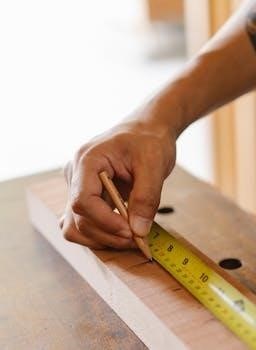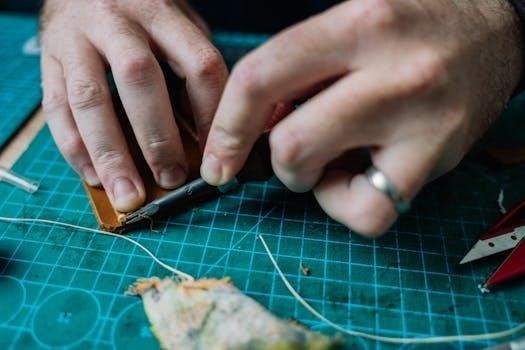
Understanding Your Rival Ice Cream Maker
Locating replacement parts for your Rival ice cream maker involves several avenues. Explore the manufacturer’s website for dedicated parts sections. Online retailers like Amazon and eBay are valuable resources‚ so check those.
Identifying Your Model
Before seeking a Rival ice cream maker instruction manual‚ pinpointing your exact model is essential. The model number is typically found on a sticker located on the base or back of the appliance.
This identifier is crucial for locating the correct manual and ensuring proper operation. Manuals vary significantly between models due to design and functionality differences.
Consulting the wrong manual can lead to operational errors or damage to the ice cream maker. Confirm the model number carefully to avoid any such issues.
Double-check the number for accuracy‚ as even slight discrepancies can yield irrelevant results. With the correct model number‚ you can easily find the appropriate instructions.
Key Components and Their Functions
Understanding the Rival ice cream maker’s key components is crucial for optimal use. The canister holds the ice cream mixture and must be pre-chilled for effective freezing. The paddle churns the mixture.
This will ensure a smooth consistency. The motor drives the paddle and requires proper assembly. The bucket holds the ice and rock salt‚ facilitating the freezing process.
Each component plays a vital role. The proper assembly is crucial for the ice cream maker to function correctly. Ignoring any part can affect the final product.
Using the right amount of ice and salt is also necessary for proper freezing. The manual will provide detailed instructions on the function of each part.

Initial Setup and Preparation
Before your first batch‚ thorough cleaning is essential. Prepare your favorite ice cream mixture and chill it for an hour. Chill the canister to maximize freezing efficiency‚ so you can enjoy the delicious result.
Cleaning Before First Use
Prior to crafting your first batch of homemade ice cream with your Rival ice cream maker‚ a thorough cleaning is paramount. Disassemble all removable parts‚ including the canister‚ dasher‚ and lid. Wash each component with warm‚ soapy water‚ ensuring to remove any manufacturing residues or dust that may have accumulated during storage or transit. Rinse thoroughly under clean‚ running water to eliminate all traces of soap. Pay close attention to crevices and areas where ice cream mixture might get trapped during operation. Allow all parts to air dry completely before reassembling the ice cream maker for its inaugural use. This initial cleaning ensures optimal hygiene.
Preparing the Ice Cream Mixture
Crafting the perfect ice cream mixture is crucial for achieving delectable results with your Rival ice cream maker. Begin by selecting your favorite recipe‚ whether it’s a classic vanilla‚ a rich chocolate‚ or an adventurous fruit-infused blend. Gather all necessary ingredients‚ ensuring they are fresh and of high quality. Follow the recipe instructions meticulously‚ combining ingredients in the specified order and proportions. Once the mixture is prepared‚ it’s essential to chill it thoroughly in the refrigerator for at least an hour‚ or preferably longer. Chilling allows the flavors to meld and the mixture to reach an optimal temperature for freezing‚ resulting in a smoother‚ creamier final product.
Chilling the Canister
Prior to churning‚ properly chilling the canister of your Rival ice cream maker is crucial for optimal freezing. Place the canister in your freezer for the recommended duration specified in your model’s instruction manual‚ typically ranging from 12 to 24 hours. Ensure the canister is completely frozen solid before use; this step is vital for achieving the desired ice cream consistency. A thoroughly chilled canister helps the ice cream mixture freeze quickly and evenly‚ preventing the formation of large ice crystals and ensuring a smooth‚ creamy texture. Neglecting to chill the canister adequately may result in icy or grainy ice cream‚ so plan ahead.

Operating the Ice Cream Maker
Operating your Rival ice cream maker involves assembling the components‚ adding ice and rock salt‚ and initiating the churning process. Refer to your specific model’s manual for detailed instructions.
Assembling the Ice Cream Maker
Before commencing the ice cream-making process‚ proper assembly of your Rival ice cream maker is crucial. Consult your model’s specific instruction manual for detailed guidance. Generally‚ this involves securely placing the canister within the bucket or housing. Next‚ attach the dasher or paddle to the motor unit‚ ensuring it’s correctly positioned for optimal churning.
The motor unit must then be carefully positioned atop the bucket‚ engaging any locking mechanisms if present. Confirm that all components are firmly in place before proceeding to add the ice cream mixture and the ice and salt mixture‚ this is an important step.
Adding Ice and Rock Salt
The addition of ice and rock salt is fundamental to the freezing process in your Rival ice cream maker. Begin by layering ice around the canister‚ leaving space at the top. Alternate layers of ice with generous amounts of rock salt. Rock salt lowers the freezing point of the ice‚ drawing heat away from the ice cream mixture within the canister.
Continue layering ice and salt until the ice level reaches near the top of the canister. Ensure a consistent distribution of salt throughout the ice. Monitor the ice level during churning‚ adding more ice and salt as needed to maintain optimal freezing temperature.
The Churning Process
The churning process is where the magic happens. Once the ice and salt are properly layered‚ turn on your Rival ice cream maker. The dasher inside the canister will begin to rotate‚ scraping the freezing ice cream mixture from the sides. This constant motion incorporates air‚ creating a smooth and creamy texture.
Listen to the motor’s sound; a slowing motor indicates the ice cream is thickening. The churning time varies‚ but typically takes 20-30 minutes. Monitor the consistency; when it reaches a soft-serve state‚ the churning is complete. Unplug the machine and prepare for the next step.
Cleaning and Maintenance
Proper cleaning and maintenance are crucial for prolonging the life of your Rival ice cream maker. Regular care ensures optimal performance and prevents the build-up of bacteria‚ keeping your homemade ice cream safe and delicious.
Disassembling and Cleaning After Use
After enjoying your homemade ice cream‚ promptly disassemble the Rival ice cream maker. Begin by unplugging the unit to ensure safety. Remove the canister‚ dasher‚ and any other detachable components. Wash these parts thoroughly with warm‚ soapy water. Avoid using abrasive cleaners or scouring pads‚ as they can damage the surfaces. Rinse each part completely and allow them to air dry. The exterior of the ice cream maker can be wiped down with a damp cloth. Ensure all parts are completely dry before reassembling or storing the unit. Regular cleaning prevents residue build-up and maintains hygiene.
Proper Storage
Proper storage of your Rival ice cream maker is crucial for its longevity. Ensure all components are completely clean and dry before storing. Store the canister and other parts in a cool‚ dry place to prevent rust or mildew. Avoid storing the ice cream maker in direct sunlight or near heat sources‚ as this can damage the plastic components. It is best to store the unit in its original box or a similar protective container to prevent dust and scratches. If space is limited‚ disassemble the unit and store the parts separately. Keep the instruction manual with the ice cream maker for future reference.

Troubleshooting Common Issues
Encountering problems with your Rival ice cream maker? Common issues include the ice cream not freezing or the motor stalling. Consult the manual for solutions and ensure proper usage.
Ice Cream Not Freezing
If your Rival ice cream maker fails to freeze the mixture‚ several factors could be at play. First‚ ensure the canister was adequately pre-chilled in the freezer for the recommended duration. Check the ice-to-salt ratio; insufficient salt can hinder freezing. Verify the motor is functioning correctly and the dasher is rotating. An overloaded canister or a mixture that’s too warm can also impede the freezing process. Refer to your Rival ice cream maker’s manual for specific troubleshooting steps. In addition‚ confirm the ice cream mixture recipe is appropriate for ice cream makers.
Motor Stalling
A stalled motor in your Rival ice cream maker can stem from a few primary causes. Overfilling the canister is a common culprit‚ placing excessive strain on the motor. Ensure the ice cream mixture isn’t too thick or viscous‚ which can also overload the motor. Check for ice buildup around the dasher or canister‚ as this can impede movement. Verify the ice-to-salt ratio is correct; insufficient salt can cause the mixture to freeze too quickly‚ stressing the motor. If the motor overheats‚ allow it to cool down before attempting to restart. Consult your Rival ice cream maker’s manual for specific guidance.

Finding Replacement Parts
Locating replacement parts for your Rival ice cream maker involves several avenues. Explore the manufacturer’s website for dedicated parts sections. Online retailers like Amazon and eBay are valuable resources.
Online Retailers
When searching for replacement parts for your Rival ice cream maker‚ online retailers provide a convenient and vast marketplace. Websites like Amazon‚ eBay‚ and Walmart often carry a range of parts‚ from canisters and motors to lids and paddles. Enter the specific model number of your Rival ice cream maker into the search bar to narrow down the results and find compatible components.
Carefully review product descriptions and customer reviews to ensure the part matches your needs. Pay attention to dimensions‚ material‚ and compatibility notes. Be sure to cross-reference with your user manual to confirm it’s the correct part.
Appliance Repair Shops
Local appliance repair shops offer a valuable resource for locating replacement parts for your Rival ice cream maker‚ especially for older or less common models. These shops often possess specialized knowledge and access to suppliers that may not be available online.
Contacting a local repair shop allows you to describe the specific part needed and receive expert assistance. They may be able to source the part‚ repair the existing one‚ or provide compatible alternatives. Furthermore‚ appliance repair shops can offer guidance on installation and troubleshooting‚ ensuring your ice cream maker operates smoothly.